
Zingiber is a genus of flowering plants in the family Zingiberaceae. It is native to Southeast Asia, especially in Thailand, China, the Indian Subcontinent, and New Guinea. It contains the true gingers, plants grown the world over for their culinary value. The most well known species are Z. officinale and Z. mioga, two garden gingers.

Antidesma is a genus of tropical plant in the family Phyllanthaceae formally described by Linnaeus in 1753. It is native to tropical Africa, S + E + SE Asia, Australia, and various oceanic islands. The greatest diversity occurs in Southeast Asia.

Arisaema is a large and diverse genus of the flowering plant family Araceae. The largest concentration of species is in China and Japan, with other species native to other parts of southern Asia as well as eastern and central Africa, Mexico and eastern North America. Asiatic species are often called cobra lilies, while western species are often called jack-in-the-pulpit; both names refer to the distinctive appearance of the flower, which consists of an erect central spadix rising from a spathe.
Balakata is a genus of trees in the family Euphorbiaceae first described as a genus in 1999. It is native to Southeast Asia, southern China, the Himalayas, and New Guinea. The genus name was inspired by balákat-gúbat ("shoulder-tree"), the Philippine common name for B. luzonica.
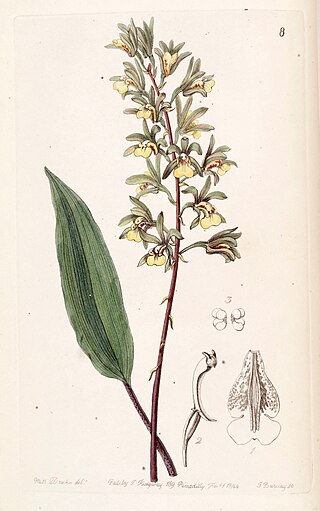
Tainia, commonly known as ribbon orchids or 带唇兰属 is a genus of about thirty species of evergreen, terrestrial orchids in the distributed from India, China, Japan, Southeast Asia to New Guinea, the Solomon Islands and Queensland.
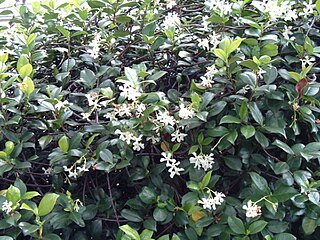
Trachelospermumstar jasmine, Confederate jasmine, is a genus of evergreen woody vines in the dogbane family Apocynaceae, first described as a genus in 1851. All species are native to southern and eastern Asia.

Odontochilus is a small genus from the orchid family (Orchidaceae). These terrestrial, mycoparasitic orchids occur from China, Japan, the Himalayas, Southeast Asia, New Guinea and Melanesia. The genus is related to Gonatostylis, endemic to New Caledonia.
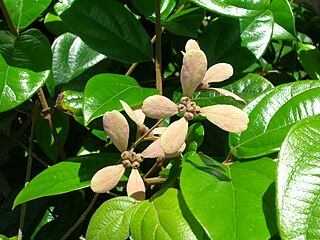
Congea is a small genus of flowering plants in the mint family, Lamiaceae, first described by William Roxburgh in 1820.

Steudnera is a genus of flowering plants in the family Araceae. It is native to southern China, the Himalayas, and Indochina. The genus was first described by Karl Koch in 1862. The genus is also believed to be closely related to Remusatia.
- Steudnera assamicaHook.f. - Arunachal Pradesh, Assam
- Steudnera capitellataHook.f. - Myanmar
- Steudnera colocasiifoliaK.Koch - Yunnan, Guangxi, Assam, Bangladesh, Indochina
- Steudnera discolorW.Bull - Assam, Bangladesh, Myanmar, Thailand
- Steudnera gageiK.Krause - Assam
- Steudnera griffithii(Schott) Hook.f. - Assam, Myanmar, Yunnan
- Steudnera henryanaEngl. - Yunnan, Laos, Vietnam
- Steudnera kerriiGagnep. - Guangxi, Laos, Vietnam, Thailand

Tricholepis is a genus of Asian plants in the tribe Cardueae within the family Asteraceae.
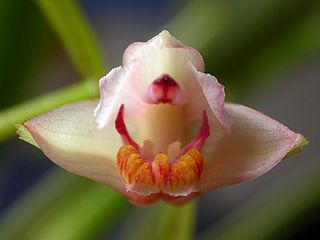
Cryptochilus is a genus of flowering plants from the orchid family, Orchidaceae. Its species are native to China, the Himalayas, and Indochina.

Pomatocalpa, commonly known as bladder orchids, or 鹿角兰属 , is a genus of about twenty five species from the orchid family, Orchidaceae. Plants in this genus are epiphytes or lithophytes with thick, leathery leaves and a large number of small flowers with a three-lobed labellum. There are about twenty five species found from tropical and subtropical Asia to the south-west Pacific.

Tupistra is a genus of about 20 species of flowering plants found in south Asia, from southern China to Sumatra and Ambon Island. In the APG III classification system, it is placed in the family Asparagaceae, subfamily Nolinoideae.

Kaempferia is a genus of plants in the ginger family. It is native to China, India, and Southeast Asia.

Elettariopsis was a genus of plants in the ginger family, that has now been subsumed into the genus Amomum. Species are native to Southeast Asia, southern China and New Guinea.

Boesenbergia is a genus of plants in the ginger family. It contains more than 90 species, native to China, the Indian Subcontinent, and Southeast Asia.
Stahlianthus is a genus of flowering plants in the ginger family. It is native to southern China, the Himalayas, and Indochina.
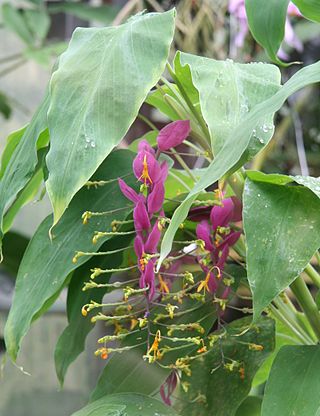
Globba is a genus of plants in the ginger family. It contains about 100 species, native to China, the Indian Subcontinent, Southeast Asia, New Guinea, the Bismarck Archipelago and Queensland.

Anisochilus is a genus in the family Lamiaceae, commonly called as Kapuri first described in 1830. It is native to China, the Indian Subcontinent, and Indochina. Has healing properties that deal with treatment for ailments known as gastric ulcer and helps with dermis issues. Anisochilus also has active properties such as camphor, leutiolin, and apigenin. A new hygrine-like compound has been found within the DNA of this plant.

Gomphostemma is a genus of flowering plants in the mint family, Lamiaceae, first described in 1830. It is native to Southeast Asia, China, and the Indian subcontinent.
- Gomphostemma aborensisDunn - Arunachal Pradesh
- Gomphostemma arbusculumC.Y.Wu - Yunnan
- Gomphostemma callicarpoides(Yamam.) Masam. - Taiwan
- Gomphostemma chinenseOliv. - Fujian, Guangdong, Guangxi, Hainan, Jiangxi, Vietnam
- Gomphostemma crinitumWall. ex Benth. - Indochina, Yunnan, Assam, Bangladesh
- Gomphostemma curtisiiPrain - Malaya, Sumatra, Borneo
- Gomphostemma deltodonC.Y.Wu - Yunnan
- Gomphostemma dolichobotrysMerr. - Sumatra
- Gomphostemma eriocarpumBenth. - southern India
- Gomphostemma grandiflorumDoan ex Suddee & A.J.Paton - Vietnam
- Gomphostemma hainanenseC.Y.Wu - Hainan
- Gomphostemma hemsleyanumPrain ex Collett & Hemsl. - Java, Myanmar
- Gomphostemma heyneanumWall. ex Benth. - southern India
- Gomphostemma hirsutumWalsingham - Sabah
- Gomphostemma inopinatumPrain - Myanmar
- Gomphostemma javanicum(Blume) Benth. - Indochina, Andaman Islands, Borneo, Sumatra, Java, Sulawesi, Bali, Lombok, Timor, Philippines
- Gomphostemma keralensisVivek., Gopalan & R.Ansari. - Kerala
- Gomphostemma laceiMukerjee - Myanmar
- Gomphostemma latifoliumC.Y.Wu - Yunnan, Guangdong
- Gomphostemma leptodonDunn - Guangxi, Vietnam
- Gomphostemma lucidumWall. ex Benth. - Indochina, Assam, Bangladesh, Guangdong, Guangxi, Yunnan
- Gomphostemma mastersiiBenth. ex Hook.f. - Assam, Bangladesh, Thailand
- Gomphostemma melissifoliumWall. ex Benth. - Assam, Bangladesh, Bhutan, Nepal
- Gomphostemma microcalyxPrain - Borneo, Malaya, Sumatra
- Gomphostemma microdonDunn - Yunnan, Laos, Thailand, Vietnam
- Gomphostemma nayariiA.S.Chauhan - Assam
- Gomphostemma niveumHook.f. - Assam, Arunachal Pradesh, Vietnam
- Gomphostemma nutansHook.f. - Assam, Myanmar
- Gomphostemma ovatumWall. ex Benth. - Assam, Bangladesh, Bhutan, Nepal
- Gomphostemma parviflorumWall. ex Benth. - Assam, Bangladesh, Bhutan, Nepal, Yunnan, Indochina, Borneo, Java, Sumatra
- Gomphostemma pedunculatumBenth. ex Hook.f. - Assam, Yunnan, Vietnam
- Gomphostemma pseudocrinitumC.Y.Wu - Guangxi
- Gomphostemma salarkhanianumKhanam & M.A.Hassan - Sylhet District in Bangladesh
- Gomphostemma scortechiniiPrain - Myanmar, Thailand, Malaya
- Gomphostemma stellatohirsutumC.Y.Wu - Yunnan
- Gomphostemma strobilinum Wall. ex Benth. - Bangladesh, Myanmar, Thailand, Vietnam
- Gomphostemma sulcatumC.Y.Wu - Yunnan
- Gomphostemma thomsoniiBenth. ex Hook.f. - Assam
- Gomphostemma velutinumBenth. - Assam, Bangladesh
- Gomphostemma wallichiiPrain - Assam, Myanmar, Thailand

















